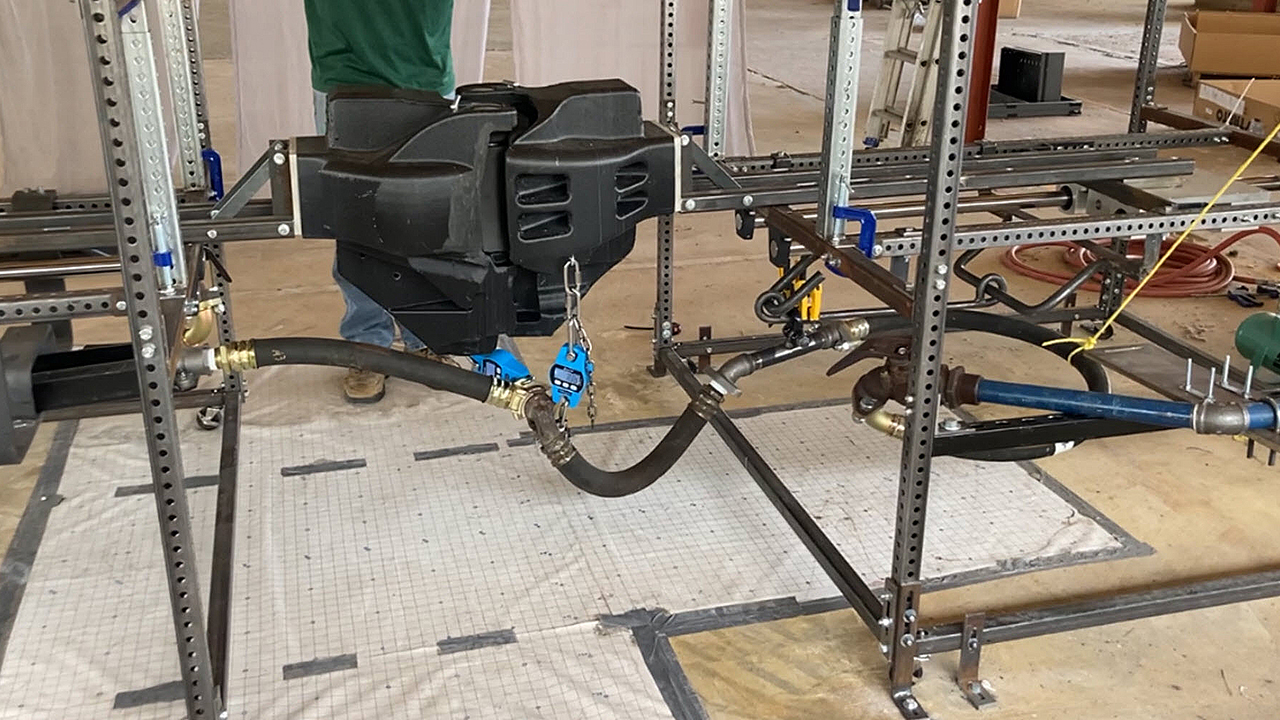
End Hose Arrangement-Caused Service Interruptions
Written by Scott Cummings, AVP Research and Innovation; and Yi Wang, Principal Investigator I, MxV Rail
Figure 1: End arrangement test rigs configured with a blocked trolley rod and a misapplied standard end hose. MxV Rail photo
MxV RAIL R&D, RAILWAY AGE SEPTEMBER 2022 ISSUE: Air hose separation (AHS) and air hose failure (AHF) are major causes for undesired emergency brake applications (UDE) on trains, and both can result in considerable service interruptions and reduced average train velocity.
To provide better insight into these issues, MxV Rail (formerly TTCI) conducted end hose separation experiments using a test rig that simulated the end-of-car hose arrangement installations (end arrangements). This work was performed as part of the Association of American Railroads (AAR) Strategic Research Initiatives (SRI) program.
Although AHS and AHF can occur regardless of car and end arrangement types, data compiled by Railinc Corporation have suggested that cars equipped with end-of-car cushioning (EOCC) are significantly overrepresented relative to the fleet size.
The end hose connections on cars with EOCC must accommodate large longitudinal coupler movements and, in some cases, substantial lateral coupler swings. Flexible end arrangements have been developed to facilitate the movement of end hoses to maintain gladhand connections while the couplers are in motion relative to the cars.
MxV Rail constructed end arranged test rigs (Figure 1, above) to facilitate the testing of different end arrangement installations. An initial test matrix was designed to explore the end arrangement performance when similar and dissimilar coupled cars were subjected to eight common car position scenarios, including buff and draft strokes on tangent and curved track. During the initial tests, the end arrangements and accessories were installed according to their respective design specifications. As a result, no AHS or AHF have been observed during the initial testing. In general, the configurations have performed well with no substantial gladhand peaking or hose kinking. No excessive forces at the gladhands or air hose supports have been measured.
Subsequently, a test matrix was developed to incorporate potential application problems into the end arrangements. These non-optimal end arrangement configurations focused on representing pairs of vehicular flatcars that account for many of the AHS and AHF events. AAR S-427 and AAR S-4003-05, the two end arrangement styles most commonly found on vehicular flatcars, were selected for testing.
The defect conditions and the positioning of the test rigs were intended to cause restricted trolley movements, peaked end hose connections, and weakened end hose connections. A total of 48 test scenarios were developed by introducing the following variables to as-built end arrangement conditions:
- Blocked trolley in the full buff or draft position.
- Improperly rotated angle cock and intermediate hose position.
- Short hose straps or intentionally peaked end hoses.
- Incorrect end hoses with standard gladhands.
- Worn standard gaskets and gladhands.
- The overall failure rate for the non-optimal tests is 35% in the laboratory environment.
Considerable differences exist between the lightweight semi-stationary test rigs and freight cars in motion. The relative force and impact exerted by end arrangement components are most likely significantly lower on the test rigs. Also, laboratory testing did not provide an environment with vibration or vertical displacements, both of which would be expected in revenue service.
Several key findings can be drawn from this work. First, end arrangements in the as-built condition, regardless of style, perform sufficiently in the lab environment and do not cause hose separation or brake pipe leakage.
Next, tests conducted in non-optimal conditions while mimicking common dysfunctionalities suggest that end hose arrangements equipped with trolleys are more prone to hose separations.
Finally, test results showed the two most important mitigations for end-arrangement-related AHS and AHF include:
- Choosing an end arrangement design that maintains a high level of functionality over the service life of the car and minimizes the opportunities for incorrect field application or repair.
- Performing correct repairs.



